 How do I begin this? I’m confronted with choices. Choices exist in our worlds as an aggregate of our preceding decisions and the decisions of those who made theirs in worlds based on the decisions of those who decided before them. . . The conscious effort that drives our decisions gives us an illusion of control, yet with a myriad of actions and occurrences that happen every instant it’s hard to even begin to fathom the conditions and compromises that define the nexus of our present. Who’s your farmer? is a popular bumper sticker slogan in the rural area where I grew up. The statement begs an understanding of those unseen and unknown that support our lives.
How do I begin this? I’m confronted with choices. Choices exist in our worlds as an aggregate of our preceding decisions and the decisions of those who made theirs in worlds based on the decisions of those who decided before them. . . The conscious effort that drives our decisions gives us an illusion of control, yet with a myriad of actions and occurrences that happen every instant it’s hard to even begin to fathom the conditions and compromises that define the nexus of our present. Who’s your farmer? is a popular bumper sticker slogan in the rural area where I grew up. The statement begs an understanding of those unseen and unknown that support our lives.
Decisions and choices are simultaneously new and mundane. The majority of our decisions are pedestrian. Move. Gather. Interact. Where do I place my foot? Where do I buy? What is my response to a stimulus? What makes each choice and decision unique is the passing of time and those ever-happening instances. You cannot step into the same stream twice. Some decisions are not yours. Do you decide your parents? Do you decide where you’re born? There are things in every equation that are pre-defined. All science embeds a set of given values.
The decisions of a friend and his son contributed to my ownership of the car pictured. With the hope of selling it to a Stanford student, John’s son responded to a Craigslist posting, as he was soliciting donations for his father’s non-profit corporation — Silicon Valley Historical Association. The car is a 2006 Zapcar (Xebra), a 3-wheeled electric car from a Santa Rosa, CA company, imported from China. After accepting the donation and replacing the exhausted batteries, the car had an intermittent problem that, in addition to the limited range inherent in its design, caused a series of failures that repeatedly left the new owner stranded. It was after the car was sitting for months in a vacant lot that my friend contacted me with an offer to give me the car.
Serendipity is the foundation for things I wear, drive, eat. . . I buy from stores and online resources for different reasons (proximity, price, selection, reputation, etc.). I decide among the choices that are available. Different sources provide different selections, yet boundaries to choice always remain. Deeper still is the serendipity of choices arising as a result of the people who are connected to our lives.
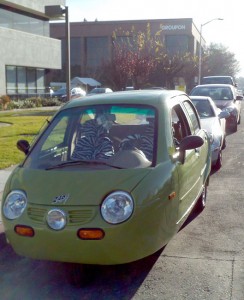 I was ready for a change in vehicles. My previous car, a ’68 Bug, needed the TLC and enthusiasm of a new owner. A car originally owned by my wife’s parents, I repaired it to rescue it from disuse and used it for over a decade. Similarly, my new car isn’t a make or model I was searching for. To the contrary, many people would question my sanity for owning it. I agreed to purchase the car for a fraction of my friend’s investment in the new batteries. It was an opportunity to explore “green” technology. The Zapcar is unusual. It is legally classified as a three-wheel motorcycle. The car was a challenge to rehabilitate. Learning and discovery always presents challenges (for more detail see “Nuts and Volts,” the story of repairing the car, below).
I was ready for a change in vehicles. My previous car, a ’68 Bug, needed the TLC and enthusiasm of a new owner. A car originally owned by my wife’s parents, I repaired it to rescue it from disuse and used it for over a decade. Similarly, my new car isn’t a make or model I was searching for. To the contrary, many people would question my sanity for owning it. I agreed to purchase the car for a fraction of my friend’s investment in the new batteries. It was an opportunity to explore “green” technology. The Zapcar is unusual. It is legally classified as a three-wheel motorcycle. The car was a challenge to rehabilitate. Learning and discovery always presents challenges (for more detail see “Nuts and Volts,” the story of repairing the car, below).
Zap! Pow! Crash!
Zap Jonway, Inc. is a company with a checkered history. Starting as a company selling electric scooters designed by a California inventor, the company set its sights on the EV market with a change in company management. It began selling its first car, the Xebra, via distributors in 2006, selling around 150 vehicles that year. In the ensuing years, the company ran into difficulties, with shoddy business practices and stock manipulation by Board members. Poor design choices led to a recall of their 2008 models sold in the U.S. Wired recounts the company’s sordid past in the article Hype Machine: Searching for ZAP’s Fleet of No-Show Green Cars.
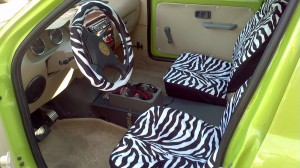 The car is a glorified golf cart. The shell is molded fiberglass. The interior dash and trim are crude. The car has a wide, flat center console with removable panel and a hinged door located under the rear seat to provide access to the batteries cradled beneath the car. I’ve purchased some parts from the manufacturer and others (including the seat covers shown) from Xebraparts.com, an online parts store established by a Zap! enthusiast. Replacement parts are scarce. Service stations are non-existent.
The car is a glorified golf cart. The shell is molded fiberglass. The interior dash and trim are crude. The car has a wide, flat center console with removable panel and a hinged door located under the rear seat to provide access to the batteries cradled beneath the car. I’ve purchased some parts from the manufacturer and others (including the seat covers shown) from Xebraparts.com, an online parts store established by a Zap! enthusiast. Replacement parts are scarce. Service stations are non-existent.
 The Zapcar is a strange, comic concept transformed into physical reality. While it’s range has diminished due to battery issues, the initial range of 15-18 miles (on flat terrain) was reasonable for local errands. The 72-volt battery pack (6 deep-cycle 12-volt AGM batteries wired in series) charges via a standard household outlet. The small, light car is energy-efficient and, registered and insured as a motorcycle, thrifty. Unfortunately, the vehicle is plagued with reliability issues. While I’m hard-pressed to find any good reason to own it, I can’t help but be fond of the idea that the car represents. The sagas of small, quirky, independent companies can be inspirational and entertaining. The Zap! story has the intrigue of failure after a short-lived success. Initially, the company was an EV darling: “Changing the World, One Car at a Time,” Zap! once boldly stated. Sometimes the wrong things are done for the right reasons. The company ran a gamut of financial and regulatory hurdles before finally building a thing that can legally and cleanly travel on city streets.
The Zapcar is a strange, comic concept transformed into physical reality. While it’s range has diminished due to battery issues, the initial range of 15-18 miles (on flat terrain) was reasonable for local errands. The 72-volt battery pack (6 deep-cycle 12-volt AGM batteries wired in series) charges via a standard household outlet. The small, light car is energy-efficient and, registered and insured as a motorcycle, thrifty. Unfortunately, the vehicle is plagued with reliability issues. While I’m hard-pressed to find any good reason to own it, I can’t help but be fond of the idea that the car represents. The sagas of small, quirky, independent companies can be inspirational and entertaining. The Zap! story has the intrigue of failure after a short-lived success. Initially, the company was an EV darling: “Changing the World, One Car at a Time,” Zap! once boldly stated. Sometimes the wrong things are done for the right reasons. The company ran a gamut of financial and regulatory hurdles before finally building a thing that can legally and cleanly travel on city streets.
I couldn’t have predicted owning this thing and didn’t set out to become a “Zap Guy.” Embracing the experience however, I have more respect for the serendipity that defines us. New cars, like new years, are a topic for discussion. The new year is a time of reinvention. With my new ride, I portray the real or assumed characteristics of Zap Guy, which include:
- eco-minded (a small carbon footprint is a move forward — just not that far)
- alternative (a twisted mind isn’t a prerequisite, but it helps)
- level-headed (stay cool by staying on top — of the hill, the ups and downs are draining)
- buzzed (the sound of racing electrons, agitated neurons, or rattling doors and windows, take your pick)
Everything Makes Waves
I don’t extol the virtues of EVs over gas-powered vehicles. Battery charging relies on power generation that is shades of dirty, whether producing “clean tech” or burning coal for the grid. Electric motors are more efficient than gasoline engines, but each form of energy has trade-offs. Miles between charges or fill-ups? Availability, convenience, efficiency and impact of power storage? The constraints of our choices define our lives. In some ways, the Zapcar has made me a better person. I’m riding my bike more. It’s reliable. I’m obeying city speed limits, mainly because the car is challenged to break them. The laws, of physics, are hard to ignore when an extra hill or leg of a trip may mean the difference in reaching home. This reality forces me to be more aware and conserving. I coast when possible, anticipate stops. A successful journey is its own reward.
Fortunately, I work in a home office so I don’t rely on the car for commuting. Unfortunately, on some errands zap has degraded to sapped as the car slowed to a crawl. 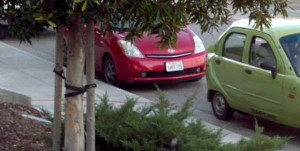 The Zapcar owner’s manual introduces the idea of “opportunity charging” — using electrical outlets for charging along your trip to extend the car’s range. I keep an extension cord in the car for this reason. On one occasion, I pulled into a service station when I was running low on power. While I couldn’t gas up, the owner generously provided use of an outlet near an outdoor vending machine. After an hour of errands nearby, I gave the garage a $0.25 thank you and was ready to move. Reading the urban energy landscape is an EV ninja skill.
The Zapcar owner’s manual introduces the idea of “opportunity charging” — using electrical outlets for charging along your trip to extend the car’s range. I keep an extension cord in the car for this reason. On one occasion, I pulled into a service station when I was running low on power. While I couldn’t gas up, the owner generously provided use of an outlet near an outdoor vending machine. After an hour of errands nearby, I gave the garage a $0.25 thank you and was ready to move. Reading the urban energy landscape is an EV ninja skill.
To be fair, other EVs are also limited in range. The owner of a Nissan Leaf told me that he charged his car at work or it wouldn’t make the round trip from home. How far can you drive without a gas station? Cars are lifestyle accessories — a composite of metal, plastic and rubber worn while moving from point to point. Wearing a Zapcar turns heads and generates smiles. The efficiency of lifestyles vary. Imagine carrying the door of your car to a local store. Now imagine carrying the door the distances you travel daily/yearly. How big is the box you move in? Our lifestyles leave footprints.
Collaboration is Personal
We can all share the expectations, joys and foibles of discovery. If you’re reading this, thanks, you are a friend. For my friends, a few words about another small, independent (and sometimes quirky) business. 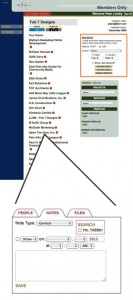 Pictured left is an interface from a suite of online tools for collaborative work I began developing in 2008, initially creating the site to manage my project tasks and invoices. More recently, I’ve added tools for members to share tasks and manage notes and files associated with projects. I continue to develop the tools for my own needs.
Pictured left is an interface from a suite of online tools for collaborative work I began developing in 2008, initially creating the site to manage my project tasks and invoices. More recently, I’ve added tools for members to share tasks and manage notes and files associated with projects. I continue to develop the tools for my own needs.
 I define tools to solve problems. I’ve created numerous websites for clients that interact with customers. I’ve developed tools at collab.us that are useful to me. Collaborative needs and feedback will help define future iterations and enhancements. AQUA is a virtual water cooler. PLAN•M is a menu system mapping links to background images used as a landscape. These ideas are incorporated to be improved upon with help from users.
I define tools to solve problems. I’ve created numerous websites for clients that interact with customers. I’ve developed tools at collab.us that are useful to me. Collaborative needs and feedback will help define future iterations and enhancements. AQUA is a virtual water cooler. PLAN•M is a menu system mapping links to background images used as a landscape. These ideas are incorporated to be improved upon with help from users.
I’m interested in value-added networking. I have as many questions as answers. Sharing your ideas and efforts can enhance the prospects of like-minded individuals. Your personal motivation contributes to a collaborative network. I’m interested in ad hoc work with mature, independent professionals who want to provide and/or receive some help with e-life. All ideas are welcome. Collaboration promotes friendship. Opportunities are everywhere. If you want to build bridges in 2015, join me at collab.us. If you want to stay in the loop on e-marketing resources, tips and trends, sign-up for THREADS. I’m interested in your suggestions. Send me a note requesting advice or offering assistance. I’m happy to share success stories helping friends and colleagues in business. Let’s Skype a virtual coffee together.
Rehabilitation Log: Nuts and Volts
ZAP is an acronym for “Zero Air Pollution.” It is also the sound of a spark, usually unexpected and inconvenient, that has negative consequences. In rehabilitating the car, I’ve had @*%zap!!# moments. Initially, the car’s intermittent problem was a mystery. Turning the key would light up the dashboard, but the car would only move forward sporadically. Clicks sounded at certain times and there seemed to be a correlation between when and where the clicks originated and if the car would move.
 A problem needs to be identified before it can be fixed. My experience with internal combustion engines did not apply to electric motors. I began researching the problem by investigating the car’s design/operation. Electrical wiring is messy and hidden in most vehicles. What makes troubleshooting electrical issues worse is the intangible, silent nature of electrons. I searched the web and discovered some postings and discussions about the car. I finally reached out to the parts department at Zap Jonway and was pleasantly surprised to be contacted by Robert, a parts clerk, offering help — he provided a link to electrical schematics for the car and assured me that repair parts were available.
A problem needs to be identified before it can be fixed. My experience with internal combustion engines did not apply to electric motors. I began researching the problem by investigating the car’s design/operation. Electrical wiring is messy and hidden in most vehicles. What makes troubleshooting electrical issues worse is the intangible, silent nature of electrons. I searched the web and discovered some postings and discussions about the car. I finally reached out to the parts department at Zap Jonway and was pleasantly surprised to be contacted by Robert, a parts clerk, offering help — he provided a link to electrical schematics for the car and assured me that repair parts were available.
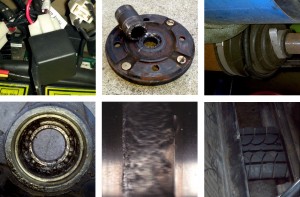 In a previous post “Motorcycle Rehab: What Does Free Cost?” I discuss the cost of a free motorcycle, in terms of time and material investments. By accepting the Zapcar, I was committed to a similar proposition — the car needed multiple repairs. While the batteries had been freshly replaced, hidden mechanical problems were surfacing. The thumbnails shown are a pictorial representation of some of the repairs I completed. Clockwise from top left: relay, hub, CV boots, battery isolation pads, wheel bearing. I attribute the failure of the hub to poor manufacturing and material quality, as it broke without unreasonable impact. The CV boots were cracking due to age and poor rubber quality. The smooth, fluid operation of bearings is imperative for a quiet ride. The wheel bearing damage could not be seen, but it could be heard: vibration and noise suggested a problem in the rear of the car. The damaged bearing (bottom left) is shown before it was removed from the suspension swing-arm. You can see a spot where there are no balls between the races of the bearing. Failure of the thin, metal cage that kept the balls evenly distributed allowed the balls to collide and grind, causing noise and vibration due to irregularities and pitting in the balls and races (bottom middle). I partially attribute battery failure to vibration caused by conditions like wheel bearing distress and bumpy roads. To isolate the batteries from the frame of the car, I added a series of rubber pads beneath the battery trays (bottom right). The pads were cut from tire tread.
In a previous post “Motorcycle Rehab: What Does Free Cost?” I discuss the cost of a free motorcycle, in terms of time and material investments. By accepting the Zapcar, I was committed to a similar proposition — the car needed multiple repairs. While the batteries had been freshly replaced, hidden mechanical problems were surfacing. The thumbnails shown are a pictorial representation of some of the repairs I completed. Clockwise from top left: relay, hub, CV boots, battery isolation pads, wheel bearing. I attribute the failure of the hub to poor manufacturing and material quality, as it broke without unreasonable impact. The CV boots were cracking due to age and poor rubber quality. The smooth, fluid operation of bearings is imperative for a quiet ride. The wheel bearing damage could not be seen, but it could be heard: vibration and noise suggested a problem in the rear of the car. The damaged bearing (bottom left) is shown before it was removed from the suspension swing-arm. You can see a spot where there are no balls between the races of the bearing. Failure of the thin, metal cage that kept the balls evenly distributed allowed the balls to collide and grind, causing noise and vibration due to irregularities and pitting in the balls and races (bottom middle). I partially attribute battery failure to vibration caused by conditions like wheel bearing distress and bumpy roads. To isolate the batteries from the frame of the car, I added a series of rubber pads beneath the battery trays (bottom right). The pads were cut from tire tread.
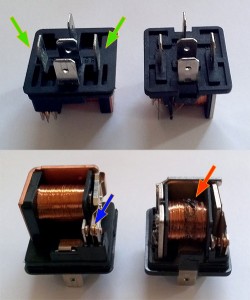 I assessed the Zapcar’s electrical schematic to understand the failures that would cause the motor to be unresponsive. Searching the schematic near the ignition switch I identified a small component and subsequently determined it was broken. The component is an electromagnetic relay, a common electrical device worthy of further discussion. The relays at right are shown with their covers removed. The state of electrical current in the winding of an electromagnetic relay determines its switch state. In the schematic, the relays JD4 and JD8 are connected to the ignition switch. I was able to determine that relay JD4 was broken by testing the electromagnet circuit (tabs indicated with green arrows) using a multimeter. The magnetic field in the electromagnet is driven by current flowing through wires wound around its steel core. The energized electromagnet attracts the switch arm (blue arrow) to flip between an “off” connection (between the central and top tabs) and “on” condition (between the central and bottom tabs). Because the circuit was “open” and no current could flow through the electromagnet winding, it was incapable of creating the magnetic field necessary for proper function of the switch.
I assessed the Zapcar’s electrical schematic to understand the failures that would cause the motor to be unresponsive. Searching the schematic near the ignition switch I identified a small component and subsequently determined it was broken. The component is an electromagnetic relay, a common electrical device worthy of further discussion. The relays at right are shown with their covers removed. The state of electrical current in the winding of an electromagnetic relay determines its switch state. In the schematic, the relays JD4 and JD8 are connected to the ignition switch. I was able to determine that relay JD4 was broken by testing the electromagnet circuit (tabs indicated with green arrows) using a multimeter. The magnetic field in the electromagnet is driven by current flowing through wires wound around its steel core. The energized electromagnet attracts the switch arm (blue arrow) to flip between an “off” connection (between the central and top tabs) and “on” condition (between the central and bottom tabs). Because the circuit was “open” and no current could flow through the electromagnet winding, it was incapable of creating the magnetic field necessary for proper function of the switch.
Completing the Circuit
Understanding the theory of operation allowed me to quickly verify the relay problem. Though it seemed simple, fixing the relay wasn’t so quick. The car’s schematic diagram (referenced above) indicates the JD4 relay is 12-volt. I ordered two replacement relays from the Zap! parts clerk in the company’s Santa Rosa, CA office.
I didn’t know that the the wiring for the Zapcar model I own differs slightly from the available schematic. Actual wires are much harder to follow than a schematic. After trial-and-error (a.k.a. @*%zap!!# moments), I discovered the JD4 relay uses 72 volts supplied by the ignition switch. Trial: I installed one of the replacement relays and turned the ignition switch. Error: POOF! a cloud of noxious smoke emitted from under the dashboard. What?! Surprised and not thinking clearly, I installed relay #2 convinced that the first relay was faulty. Key->Turn->Click->POOF! It took sacrificing a third relay before I was finally jolted to consult this Zap! documentation. On page 9 of the document, it specifies the profile of 72-volt relays that matched the original relay. (The documentation was the only reference of the relay’s voltage — 72-volt relays in the Zapcar are not imprinted with this specification.) Experience and understanding are hard-gained from @*%zap!!# moments. The schematic from this document was incorrect for my car. I was initially ignorant of this statement in the document: “This document describes the original wiring with the 12V key ignition system. Do not use this manual for the 72V key ignition system.” I now know that my car has a 72V key ignition system. Component labeling would have flagged the discrepancy.
In the picture above, the relays on the left and right are 72-volt and 12-volt, respectively. The melted mass of wire insulation (red arrow) is evidence that the 12-volt relay “burned out” due to excess voltage. The reason for the failure of the 72-volt relay was not visibly evident. The “break” was evident by testing the electromagnet wiring. The intermittent nature of the relay suggests that the break was microscopic and occasionally allowed the electrons to flow and energize the magnetic field. Eventually the connection failed completely and would not engage no matter how many times the key was turned on and off (the temperature of the relay was a factor, i.e. the relay was more likely to engage when cold due to contraction of the wire’s electrons).
Batteries Included
Modern, gas-powered cars have sophisticated electrical systems. Electrical dashboard instruments, lights and accessories are common to all cars. Spinning alternators and generators charge the batteries of gas-powered cars while the cars are driven. Driving a gas-powered vehicle improves its state of charge. Driving an electric vehicle depletes its state of charge.
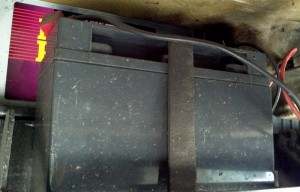 The Zapcar has seven batteries. Six large 12-volt AGM batteries provide power to the drive motor. The 7th battery is smaller. It supplies 12-volt power to the dashboard, accessories and some relays (72-volt relays are powered by the “Traction Pack”). When the ignition switch is on, a DC-DC converter attached to the 72-volt pack supplies current for charging the small battery as well as providing 12-volt power throughout the car. If the 72-volt pack is weak or the DC-DC converter is not working, charging current is affected and the small battery can drain to a point where the dashboard and headlights suddenly go dark while driving. The electronic speedometer and 12-volt accessories quit (the car’s heater is 72 volts — presumably to allow you stay warm while you are stranded at night). Because the 72-volt relay in the drive motor control circuit isn’t affected by a depleted 7th battery, the car can continue to move. If the 7th battery is drained, use an external trickle charger to charge it. The terminals of the battery are accessible by removing the center console panel. A depleted 7th battery can cause the 20A fuse (F1) to fail due to charging current overload. Fix a weak battery pack to address issues with the 7th battery. Also check DC-DC converter connections and output.
The Zapcar has seven batteries. Six large 12-volt AGM batteries provide power to the drive motor. The 7th battery is smaller. It supplies 12-volt power to the dashboard, accessories and some relays (72-volt relays are powered by the “Traction Pack”). When the ignition switch is on, a DC-DC converter attached to the 72-volt pack supplies current for charging the small battery as well as providing 12-volt power throughout the car. If the 72-volt pack is weak or the DC-DC converter is not working, charging current is affected and the small battery can drain to a point where the dashboard and headlights suddenly go dark while driving. The electronic speedometer and 12-volt accessories quit (the car’s heater is 72 volts — presumably to allow you stay warm while you are stranded at night). Because the 72-volt relay in the drive motor control circuit isn’t affected by a depleted 7th battery, the car can continue to move. If the 7th battery is drained, use an external trickle charger to charge it. The terminals of the battery are accessible by removing the center console panel. A depleted 7th battery can cause the 20A fuse (F1) to fail due to charging current overload. Fix a weak battery pack to address issues with the 7th battery. Also check DC-DC converter connections and output.
 Batteries are like apples — wired in series, one bad battery spoils the output of them all. The health of the car’s batteries has a direct impact on the health of the car. You can’t ignore a battery issue — the range of your EV diminishes. Batteries are mysterious. Electrochemical processes that generate electricity are known chemistry. The magic is harnessing these processes with real materials and designs. The lead-acid battery is an automobile technology workhorse. The life of these batteries is limited for many reasons, including variable operating conditions and abuses. The Zapcar’s six-battery Traction Pack is charged as a unit with an onboard 72-volt charger. A dashboard meter provides a rough indication of the total voltage of the pack, but batteries may not contribute equally. How do you “see” inside a battery? With numbers. For clues on the poor performance of the car, I persistently recorded the voltage of each battery before and after use. I was interested in relative strengths and trends. Based on its lower values, I concluded that battery #3 (my label) was under-performing. To verify this required measuring the current provided by the batteries.
Batteries are like apples — wired in series, one bad battery spoils the output of them all. The health of the car’s batteries has a direct impact on the health of the car. You can’t ignore a battery issue — the range of your EV diminishes. Batteries are mysterious. Electrochemical processes that generate electricity are known chemistry. The magic is harnessing these processes with real materials and designs. The lead-acid battery is an automobile technology workhorse. The life of these batteries is limited for many reasons, including variable operating conditions and abuses. The Zapcar’s six-battery Traction Pack is charged as a unit with an onboard 72-volt charger. A dashboard meter provides a rough indication of the total voltage of the pack, but batteries may not contribute equally. How do you “see” inside a battery? With numbers. For clues on the poor performance of the car, I persistently recorded the voltage of each battery before and after use. I was interested in relative strengths and trends. Based on its lower values, I concluded that battery #3 (my label) was under-performing. To verify this required measuring the current provided by the batteries.
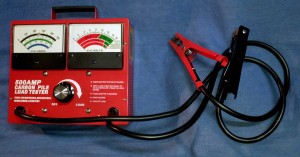 For me, working on an electric vehicle required new tools — mental and material. One advantage of an EV using common technology: an ordinary carbon pile load tester could be used to analyze the batteries. I found numerous low-cost models on eBay and chose one rated at 500AMP, sufficient for batteries up to 1000CCA (the car’s batteries are 800CCA). The dual-gauge unit is simple to operate. Turning the knob applies a load across the terminals of the battery. When the left gauge (D.C. Amps) reaches half the CCA capacity of the battery, watch the right gauge (D.C Volts). The health of the battery is determined by the voltage drop during a 15-second test. There is embedded knowledge in the information design of the tester. Beneath the absolute values (i.e. AMPS and VOLTS), the gauges have translation scales for different specifications (amp hour/cold cranking amp on D.C. Amps gauge) and common pass/fail interpretations (battery test/state of charge/alternator and regulator test on D.C. Volts gauge).
For me, working on an electric vehicle required new tools — mental and material. One advantage of an EV using common technology: an ordinary carbon pile load tester could be used to analyze the batteries. I found numerous low-cost models on eBay and chose one rated at 500AMP, sufficient for batteries up to 1000CCA (the car’s batteries are 800CCA). The dual-gauge unit is simple to operate. Turning the knob applies a load across the terminals of the battery. When the left gauge (D.C. Amps) reaches half the CCA capacity of the battery, watch the right gauge (D.C Volts). The health of the battery is determined by the voltage drop during a 15-second test. There is embedded knowledge in the information design of the tester. Beneath the absolute values (i.e. AMPS and VOLTS), the gauges have translation scales for different specifications (amp hour/cold cranking amp on D.C. Amps gauge) and common pass/fail interpretations (battery test/state of charge/alternator and regulator test on D.C. Volts gauge).
SEO and You Shall Reap
I enjoyed friendly, personal service obtaining parts for my repairs. I experienced the enthusiasm and cohesion of the fringe — the shared conviction and circumstance of owning a Zapcar. The car and company are on the fringe. Along with the few people who own and support it, I share a commitment to the vehicle. Club membership affords some familiarity and respect among its members. We all join clubs, whether we pay dues or not. Clubs give us a sense of belonging. They are a large factor in our allegiances.
Consider this post a contribution to the fringe. My purpose is not to reach Zapcar owners exclusively, as the number of those who actually read these words may be counted on one hand or even one finger. But I appreciate those who support the fringe, even if it’s just a tent stake in the ground. On my quest for repair support I visited a few digital backwaters. At one, www.zapowner.com, webmaster Ryan writes with passion about EV techology in his post.
This post contains troubleshooting tips, but the story is larger than the topic. Reading this? Friend, family, colleague, associate, stranger: I appreciate your consideration. Who did I write this for? My target audience is pulwaterly. “Pulwaterly” is not a Google or Yahoo search result. . .yet. The meaning of the word? ANYTHING YOU WANT.
Pulwaterly
To my colleagues regarding Search Engine Optimization (SEO), I recommend being unique. This post is not just a story, but a tag cloud. Another stream of characters in this hyper, linked world. Words make it more or less than an idea. What search or link did you follow?
 QuiQ Charger Algorithms (.enc) QuiQ Charger Algorithms (.enc)The algorithms below were provided by JLG Ground Support to support my purchase of a QuiQ charger programmer. While some algorithms do not apply to the Zapcar, I offer them for anyone interested in modifying a QuiQ charger. |
|
| 1 | Trojan T105 |
| 2 | Trojan T105 tapped |
| 3 | Trojan T105 const power |
| 5 | Trojan 30/31XHS*† |
| 6 | Deka 8G31 Gel* |
| 7 | Trojan J305 const power |
| 8 | Concorde 10xAh AGM |
| 23 | JLG/Douglas const power |
| 42 | Discover 80-150Ah AGM* |
| 43 | Discover 200-400Ah AGM* |
| 73 | Generic 400Ah flooded const power |
| * indicates algorithms for popular Zapcar batteries † Zap! service manual states to use this algorithm with Discover AGM EV31A-A, EV12A-A and Interstate DCM 0100 |
|
Here’s to embracing the fringe to increase your search relevance.


Hello Peter, I got a real kick out of this post. First, I too own a 68 Volkswagen Beetle (what are the odds?)! It’s presently rotting away in my yard with bad brakes, and a floor that no longer supports seats. I don’t want to talk about that. 😉 I had plans of getting a brand new electric car this year, but I didn’t want to lay down the $35k for one. So instead I bought a Zap URBEE. There is a lot to this story. But let’s just say, Zap tells me that they haven’t actually imported any of these. And so I am left wondering what factory in China really made these and put Zap’s name on them? It was originally sold by Massimo Motors who will only tell me “we don’t sell those any more”. Hrm. Anyhow – I am presently trying to fit my URBEE with a new controller. The existing controller is limited in speed to 24mph, and while it may be programmable, I will likely never ever find any documentation or programming software on it. It doesn’t even have a name! Just a big black box. I have plenty of pictures uploaded if you want to check it out. After asking around, I was told that I need to talk to Dennis Vickrey at Zap. He has been very helpful and is attempting to find me some documentation or schematics on this controller so that I can identify a few wires with functions unknown (talk about tough to trace!!). Any chance you could share your Zap contact with me (Robert)? I would like to pick the guys brain, and I am pretty sure I haven’t spoken to him or emailed him yet. As promised, here are some pictures. If you have the time, and the desire, hit me up with an email! Oh, and nice Zap you got there, bro. 😉
Just got off the phone with Zap Jonway. They do have some limited parts for the 2006 Zap Xebra PK pickup I am looking at buying. The gentleman I was talking with (?Sal?) was very congenial.
This blog is phenomenal. What a great introduction to the nitty gritty of sorting out the wiring schematics of the Zap. Thanks so much for sharing this information.:-)